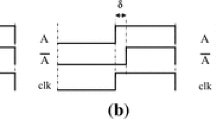Abstract
Power analysis attack is a form of side channel attack which can recover the key of a cryptographic algorithm running on some device. In this work we propose CAD based methodology to perform power analysis on pre-silicon gate-level netlist of cryptographic algorithm. We first build a new leakage model of the critical component present in crypto design by approximating it’s dynamic power consumption from the toggle count information. Then using the power model we perform power attack to recover key using power trace of crypto design. We validated our methodology on PRESENT like cipher structure and also compared our leakage model with popular Hamming distance and Hamming weight models, where we found our model requires very less number of power traces to recover keys with high correlation. We further extended our model to work by counting the number of toggles, that can be exploited by the circuit designers to early detect if their crypto design is vulnerable to any leakage or by tool developers to induct security awareness in their flow. Finally, we integrated our methodology with hybrid testing framework for first order side channel analysis to certify crypto-implementations from pre-silicon power analysis.













Similar content being viewed by others
References
Akkar ML, Bevan R, Dischamp P, Moyart D (2000). In: Okamoto T (ed) Proc. advances in cryptology — ASIACRYPT 2000. Springer, Berlin, pp 489–502
Bayrak AG, Regazzoni F, Brisk P, Standaert F, Ienne P (2011). In: Proceedings of the 48th design automation conference, DAC 2011, San Diego, California, USA, June 5–10, 2011, pp 230–235, DOI https://doi.org/10.1145/2024724.2024778, (to appear in print)
Brier E, Clavier C, Olivier F (2004). In: Joye M, Quisquater JJ (eds) Proc. cryptographic hardware and embedded systems - CHES 2004. Springer, Berlin, pp 16–29
Chandrakasan AP, Brodersen RW (eds.) (1997) Low-power CMOS design, 1st edn. Wiley-IEEE Press
Goodwill G, Jun B, Jaffe J, Rohatgi P (2011)
He MT, Park J, Nahiyan A, Vassilev A, Jin Y, Tehranipoor M (2019). In: Proc. 37th IEEE VLSI test symposium, VTS 2019, Monterey, CA, USA, April 23–25, 2019, pp 1–6, DOI https://doi.org/10.1109/VTS.2019.8758600, (to appear in print)
Huss SA, Stöttinger M, Zohner M (2013). In: AMASIVE: an adaptable and modular autonomous side-channel vulnerability evaluation framework. Springer, Berlin, pp 151–165, DOI https://doi.org/10.1007/978-3-642-42001-6_12, (to appear in print)
Knudsen LR, Leander G. (2011) PRESENT– block cipher. Springer, Boston, pp 953–955
Kocher P, Jaffe J, Jun B (1999). In: Wiener M (ed) Proc. advances in cryptology — CRYPTO’ 99. Springer, Berlin, pp 388–397
Liu H, Qian G, Goto S, Tsunoo Y (2011). In: Chung Y, Yung M (eds) Proc. Information security applications. Springer, Berlin, pp 191–205
Mangard S, Pramstaller N, Oswald E (2005). In: Rao JR, Sunar B (eds) Proc. Cryptographic hardware and embedded systems – CHES 2005. Springer, Berlin, pp 157–171
Peeters E, Standaert FX, Quisquater JJ (2007) . Integr VLSI J 40(1):52. https://doi.org/10.1016/j.vlsi.2005.12.013
Roy DB, Bhasin S, Guilley S, Heuser A, Patranabis S, Mukhopadhyay D (2019) . IEEE Trans Comput 68(3):347. https://doi.org/10.1109/TC.2018.2875746
Sadhukhan R, Datta N, Mukhopadhyay D (2019). In: Proc. 32nd International conference on VLSI design and 2019 18th international conference on embedded systems, VLSID 2019, Delhi, India, January 5–9, 2019, pp 531–532, DOI https://doi.org/10.1109/VLSID.2019.00121, (to appear in print)
Sadhukhan R, Datta N, Mukhopadhyay D (2019) IEEE Trans Very Large Scale Integr(VLSI) Syst, 1–13. https://doi.org/10.1109/TVLSI.2019.2925421
Sakiyama K, Sasaki Y, Li Y (2015) Security of block ciphers: from algorithm design to hardware implementation, 1st edn. Wiley Publishing
Specification for the advanced encryption standard (aes). Federal Information Processin Standards Publication 197 (2001). http://csrc.nist.gov/publications/fips/fips197/fips-197.pdf
Standaert FX, Malkin TG, Yung M (2009). In: Joux A (ed) Proc. advances in cryptology - EUROCRYPT 2009. Springer, Berlin, pp 443–461
Veshchikov N, Guilley S (2017). In: Proc. 2017 IEEE European symposium on security and privacy, EuroS&P 2017, Paris, France, April 26–28, 2017, pp 51–59, DOI https://doi.org/10.1109/EuroSP.2017.31, (to appear in print)
Zhou Y, Feng D (2005) Side-channel attacks: ten years after its publication and the impacts on cryptographic module security testing. http://eprint.iacr.org/2005/388. Zyb@is.iscas.ac.cn 13083 received 27 Oct 2005
Author information
Authors and Affiliations
Corresponding author
Additional information
Responsible Editor: K. Basu
Publisher’s Note
Springer Nature remains neutral with regard to jurisdictional claims in published maps and institutional affiliations.
Rights and permissions
About this article
Cite this article
Sadhukhan, R., Mathew, P., Roy, D.B. et al. Count Your Toggles: a New Leakage Model for Pre-Silicon Power Analysis of Crypto Designs. J Electron Test 35, 605–619 (2019). https://doi.org/10.1007/s10836-019-05826-8
Received:
Accepted:
Published:
Issue Date:
DOI: https://doi.org/10.1007/s10836-019-05826-8




